We enjoyed this delightful soup last night paired with warm homemade bread, and it was a hit!
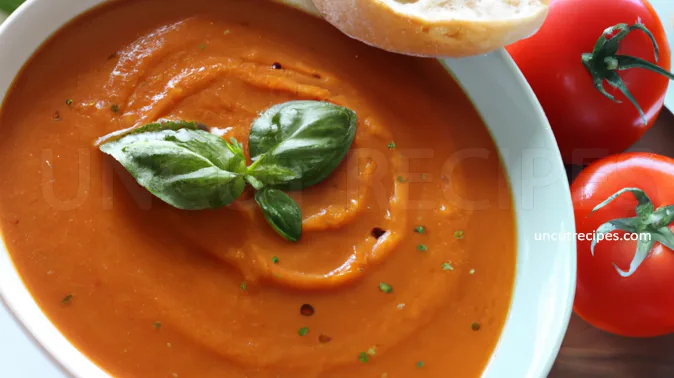
Sometimes, there's just nothing like a good soup. Whether you're basking in the summer sun or snuggling up on a cold winter's day, a bowl of our rich and creamy tomato basil soup can make any day brighter. This isn't just a recipe, it's a comfort food for all seasons, ready to warm your heart and please your palate no matter the weather outside.
Think of this as more than just a meal - it's a moment of pure culinary bliss. The perfect union of ripe tomatoes, aromatic basil, luscious cream, and rich butter creates a symphony of flavors that's both hearty and indulgent. The beauty of it lies in its simplicity. Each ingredient brings something special to the table, turning the humble act of making soup into a joyous celebration of good food.
The ritual starts with tomatoes and tomato juice, their vibrant color a testament to their fresh, juicy flavor. As they simmer gently, they create a sweet and tangy broth that serves as the heart of our soup. Then we add in the basil leaves, their aroma a promise of the herbal undertones that will delight your taste buds.
But what's a good soup without some texture? That's where our immersion blender comes into play. It transforms our soup into a velvety-smooth concoction, ensuring each spoonful is a delightful experience. The finishing touch of cream and butter gives our soup its characteristically rich and creamy texture, while also adding a depth of flavor that makes it irresistibly good.
JUMP TO:
INGREDIENTS:
Tomato Juice and Tomato: Fresh tomatoes are the lifeblood of this soup, contributing a burst of flavor that lays the foundation for the other ingredients. Look for ripe, vibrant red tomatoes that are firm to the touch but not hard. Tomato juice can also be found in stores, but if you want to make it at home, you can blend ripe tomatoes and strain the pulp. This gives you control over the sweetness and acidity levels of your juice. The beauty of this soup is that it can be made with any variety of tomato, so feel free to experiment with different types to see which one you like best.
Heavy Cream: This ingredient lends creaminess and richness to the soup. When selecting heavy cream, opt for one with a high percentage of milk fat (around 36%) for the best texture. Alternatively, if you want to make your own half-and-half, combine equal parts of whole milk and heavy cream. This can be a lighter option if you're watching your fat intake.
Butter: Butter adds a depth of flavor and a silky finish to the soup. For this recipe, choose unsalted butter so you have better control over the soup's sodium content. Always go for high-quality butter, as it can truly elevate the flavor of the dish. Margarine can be used as an alternative, but the flavor won't be as rich.
Fresh Basil: Basil lends an aromatic and slightly sweet note that balances the tanginess of the tomatoes. Look for fresh leaves that are vibrant green and free from dark spots or wilting. It's best to add fresh basil right before serving to preserve its bright flavor. If fresh basil is not available, dried basil can be used as an alternative, but reduce the amount as its flavor is more concentrated.
MAIN STEPS:
Tomato Simmering: While it may be tempting to rush this step, letting your tomatoes and tomato juice simmer gently for the suggested 30 minutes is essential. It's during this time that the tomatoes break down, melding with the juice to form a robust, flavorful base. Cooking them for less time might not allow them to break down fully, which could result in a soup with a less balanced flavor.
Adding the Basil: Basil is a delicate herb, and its volatile oils, which carry the flavor, can easily be lost with too much heat. That's why we add the basil off heat, letting the residual warmth do the work. So resist the urge to put the pot back on the heat right after adding the basil; let it steep, and allow its flavors to bloom.
Blending: Using an immersion blender is ideal for this step as it allows you to control the soup's consistency directly in the pot. It's essential to blend the soup until it's completely smooth for a velvety texture. However, be careful not to overblend as it could incorporate too much air into the soup, making it frothy.
Adding Heavy Cream and Butter: Patience is critical here. Rushing and turning the heat too high can cause the dairy to curdle or the soup to boil, which we want to avoid. The cream and butter should be incorporated slowly, at a gentle heat, to create a rich and creamy texture.
SERVED WITH:
Starter: Caprese Skewers (Italy): Mini mozzarella balls, cherry tomatoes, and fresh basil leaves threaded onto skewers. Light, flavorful, and the perfect Italian inspired start to your meal, they echo the tomato and basil flavors in your soup.
Side Dish: Fougasse Bread (France): This is a traditional French flatbread, often shaped and cut to resemble an ear of wheat. Its soft interior and crisp crust make it ideal for dipping into the rich soup.
Main Course: Chicken Piccata (Italy): A classic Italian dish made with chicken breasts that are seasoned, lightly dredged in flour, and then sautéed. It's served with a tangy sauce made with lemon juice, capers, and white wine, a bright and acidic contrast to the creamy soup.
Second Course: Grilled Eggplant Rollatini (Italy): Grilled slices of eggplant filled with ricotta and parmesan cheese, then rolled up and baked in tomato sauce. It's a hearty vegetarian dish that pairs well with the soup, offering a different texture and more robust flavor.
Dessert: Lemon Sorbet (Italy): A light, refreshing dessert that will cleanse your palate after the rich soup, enhancing the finish of your meal.
Cake: Orange Almond Cake (Spain): A moist and dense cake made with whole oranges and ground almonds. This gluten-free dessert provides a sweet and slightly tangy counterpoint to the savory soup.
Drink: Chardonnay (France): A white wine known for its citrus notes and hints of apple and pear. This wine has a good balance of acidity and body, making it a great match for the richness of the tomato and cream in your soup.
ALTERNATIVES:
Main Course: Shakshuka (North Africa): This popular North African dish consists of eggs poached in a sauce of tomatoes, chili peppers, and onions, spiced with cumin. Although it typically doesn't include cream or basil, you can easily sprinkle some fresh basil on top and serve it with a dollop of cream for a unique twist.
Side Dish: Tomato Basil Bruschetta (Italy): This simple yet flavorful Italian appetizer features grilled bread rubbed with garlic and topped with a mixture of diced tomatoes, basil, and olive oil. You can add a drizzle of cream or a sprinkle of cheese for added richness.
Main Course: Tomato Basil Pasta (Italy): This classic Italian dish combines fresh tomatoes and basil with pasta and a touch of garlic. A splash of cream can make this already delightful dish even more indulgent.
Main Course: Tomato Basil Chicken (Mediterranean): In this dish, chicken breasts are seared and then simmered in a sauce of fresh tomatoes and basil. A little cream can be added to the sauce to give it a richer texture and milder flavor.
Dessert: Tomato Basil Ice Cream (Modern American Fusion): An avant-garde dessert option that combines the savory notes of tomato and basil with the sweetness of ice cream. A dash of cream enhances the texture, while a sprinkle of black pepper adds a surprising kick.
Side Dish: Tomato Basil Risotto (Italy): This creamy, comforting Italian dish is made by slowly cooking Arborio rice with a mixture of tomatoes, basil, and broth. Cream and butter are often added at the end to make it extra rich and creamy.
Drink: Tomato Basil Bloody Mary (USA): A twist on the classic Bloody Mary cocktail, this version includes fresh basil for an herby kick. The cream isn't typically included, but if you're feeling adventurous, you can add a touch of cream for a unique Creamy Bloody Mary.
HISTORY:
Tomato Basil Soup is one of those dishes that doesn't have a single, clear origin point, but instead has been influenced by various cultures and cooking traditions over the years.
The use of tomatoes in cooking dates back to ancient times in Central and South America, where they were first cultivated. After the Spanish colonization of the Americas, tomatoes were introduced to Europe in the 16th century and gradually became a vital part of Mediterranean cuisine.
However, it wasn't until the 19th century that tomatoes began to gain popularity in North America, where they were initially considered ornamental plants and later thought to be poisonous due to their membership in the nightshade family. The invention of condensed tomato soup by Joseph Campbell in 1897 dramatically changed this perception and made tomato soup a household staple in the United States.
The addition of cream to tomato soup can also be traced back to Campbell’s, who released their Cream of Tomato Soup in the early 20th century. This variation introduced a rich, velvety texture to the classic tomato soup, making it an instant favorite among consumers.
The incorporation of basil into this mix is heavily influenced by Italian cooking. Basil is a beloved herb in Italy and is often paired with tomatoes in many dishes like Caprese salad, pasta sauce, and bruschetta due to the complementary flavors.
Over the years, many cooks and chefs have put their unique spin on this classic combination, leading to the creation of the rich and creamy tomato basil soup we know today. It has grown into a beloved comfort food in many parts of the world and is enjoyed in various forms, whether it's a quick canned soup for a weekday lunch or a carefully crafted dish in a gourmet restaurant.
In contemporary culture, tomato basil soup is seen as a warm, comforting dish often associated with nostalgia and home cooking. Its vibrant color, rich texture, and the combination of sweet, tart, and herby flavors continue to charm people across the globe, making it a timeless favorite. Despite its humble beginnings, the rich and creamy tomato basil soup stands as a testament to the universality of good food and the magic that can happen when simple, quality ingredients come together.
TIPS:
Sweating the Tomatoes: Before adding the tomatoes to the tomato juice, consider sweating them lightly in a pan with a bit of olive oil. This technique helps to draw out the tomatoes' natural sugars and deepen their flavor.
Basil Infused Oil: If you want to add an extra touch of basil to your soup, try making a basil infused oil. Simply heat some olive oil in a pan, add extra basil leaves and let them sizzle for a few minutes. Drizzle this oil on top of your soup before serving for an added layer of flavor.
Tomato Roasting: Roasting the tomato before adding it to the juice can add a rich, smoky flavor to the soup. To do this, cut the tomato in half, drizzle with olive oil, sprinkle with salt and pepper, and roast in a 375°F (190°C) oven for about 20-30 minutes.
Cream Tempering: To avoid the cream curdling when added to the hot soup, you can temper it. This involves gradually adding some of the hot tomato juice to the cream to slowly raise its temperature before introducing it to the rest of the hot soup.
Fresh Basil: When adding the basil, remember to save some fresh leaves for garnishing at the end. This will not only enhance the presentation but also give a burst of fresh flavor in each bite.
Texture Adjustment: If you prefer a chunkier soup, you can set aside some of the softened tomatoes before blending, and then add them back into the soup after the cream and butter are incorporated.
Recipe Information
Skill Level
|
Time 50 Minutes |
Price
|
Serves 4 People |
| Healthiness |
Nutritional Information |
| Ratings (Add Rating & Review) |
Reviews 18 Reviews |
Ingredients:
-
4 cups Tomato Juice
4 Tomatoes
( peeled, seeded and diced )
1 cup Heavy Cream
0.5 cup Butter
14 leaves fresh Basil
Salt
( to taste )
Black Pepper
( to taste )
Allergens
| Dairy |
Directions:
01 - Start by placing your Tomatoes and Tomato Juice into a stockpot and adjust the heat to medium. Allow the mixture to heat up until it begins to simmer. Keep it at this gentle simmer and let the Tomatoes cook until they soften, which should take about 30 minutes. During this time, the tomatoes should break down and mix with the juice, creating a flavorful base for your Soup.
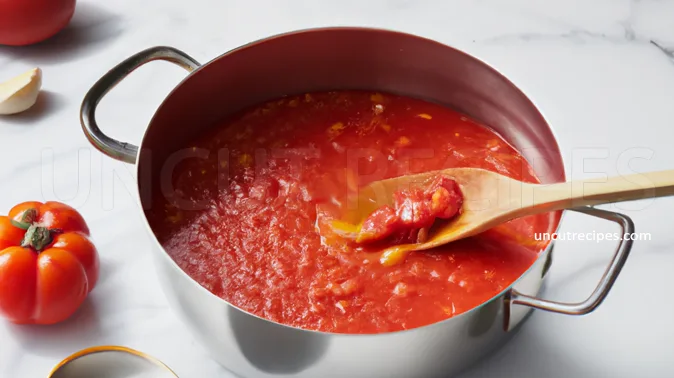
02 - Once your Tomatoes have softened, remove the pot from the heat. Now it's time to add your fresh Basil leaves. Spread them evenly in the pot, making sure they're submerged in the hot Tomato mixture. The residual heat in the pot will wilt the basil leaves, releasing their fragrant aroma and infusing the Soup with a lovely herbal note.

03 - Now, you're going to use an immersion blender to blend the Soup until it's smooth.

04 - Once your Soup is nicely blended, you're going to add the Heavy Cream and Butter. Put the pot back on the stove over medium heat. As the Soup heats up, stir it constantly to help the Cream and Butter mix in evenly. The cream will give your soup a rich, velvety texture, while the butter adds a wonderful depth of flavor. This process should take around 5 minutes. Be careful not to let the soup come to a boil; we just want it hot enough to melt the butter.
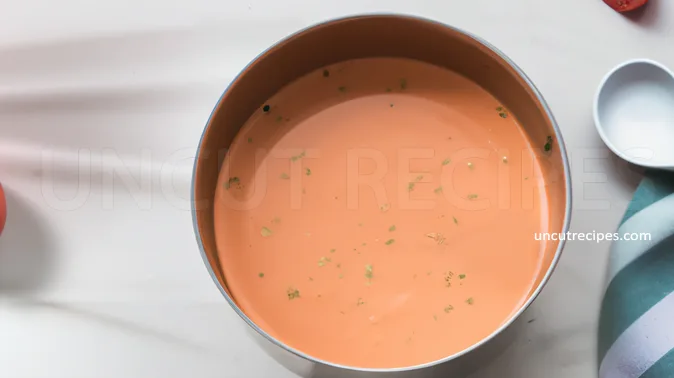
05 - Now, taste your Soup and add Salt and Black Pepper as needed. Remember, it's always best to start with a little and add more if necessary.
06 - Your delicious Rich and Creamy Tomato Basil Soup is now ready to serve! Ladle it into bowls while it's still hot for the best experience. Each spoonful should be a delightful blend of sweet Tomatoes, aromatic Basil, and Creamy goodness. Enjoy your homemade Soup!

Notes:
Choosing the right Tomatoes: While any type of tomatoes can be used for this recipe, ripe and juicy tomatoes will give your soup a richer and more robust flavor. If fresh tomatoes aren't available, canned whole tomatoes can be used as an alternative.
Tomato Juice: Tomato juice adds to the flavor of the soup, but you could also use vegetable broth for a different flavor profile.
Fresh Basil: Fresh basil leaves are best for this recipe as they impart a distinct aroma and flavor that dried basil cannot replicate. Here... you will really need fresh Basil Leaves. Sorry!
Adding the Cream and Butter: Make sure the heat is at medium and not high, to avoid the cream from curdling. Also, keep stirring the soup as the butter melts to ensure it emulsifies properly into the soup and doesn't just float on top.
Serving Suggestions: This soup pairs well with a side of crusty bread or a grilled cheese sandwich. You could also garnish it with a dollop of sour cream, a sprinkle of parmesan, or some fresh basil leaves for added presentation.
Storing the Soup: The soup can be stored in an airtight container in the refrigerator for 3-4 days. For longer storage, you can freeze the soup. Just leave out the cream and butter and add them when you're ready to reheat and serve. It's best to freeze the soup in individual servings for easy defrosting and reheating.
Nutritional Information
( Per Portion )
|
Calories |
550 kcal (27.5%) |
| Total Carbohydrate | 25g (9.1%) |
| Cholesterol | 110mg (36.6%) |
|
Total Fat |
45g (69.2%) |
| Saturated Fat | 28g (140%) |
| Polyunsaturated Fat | 1.5g (6.25%) |
| Monounsaturated Fat | 13g (54.2%) |
| Trans Fat | 1g |
| Fibers | 2g (8%) |
| Protein | 5g (10%) |
| Sugar | 18g (36%) |
|
Vitamin A |
1600 IU (32%) |
|
Vitamin B1 (Thiamin) |
0.1mg (6.7%) |
| Vitamin B2 (Riboflavin) | 0.15mg (8.8%) |
| Vitamin B3 (Niacin) | 1.3mg (6.5%) |
| Vitamin B5 (Pantothenic Acid) | 0.9mg (18%) |
| Vitamin B6 | 0.2mg (10%) |
| Vitamin B7 (Biotin) | 4mcg (13.3%) |
| Vitamin B9 (Folate) | 30mcg (7.5%) |
| Vitamin B12 | 0.3mcg (12.5%) |
| Vitamin C | 50mg (83.3%) |
| Vitamin D | 10 IU (2.5%) |
| Vitamin E | 1mg (5%) |
| Vitamin K | 50mcg (25%) |
| Choline | 20mg (3.6%) |
| Carnitine | 8mg |
|
Calcium |
100mg (10%) |
|
Chloride |
85mg (3.7%) |
| Chromium | 4mcg (3.3%) |
| Copper | 0.1mg (5%) |
| Fluoride | 0.5mcg (14.3%) |
| Iodine | 8mcg (5.3%) |
| Iron | 1mg (5.6%) |
| Magnesium | 30mg (7.5%) |
| Manganese | 0.2mg (10%) |
| Molybdenum | 7mcg (15.6%) |
| Phosphorus | 80mg (8%) |
| Potassium | 675mg (19.3%) |
| Selenium | 5mcg (7.1%) |
| Sodium | 600mg (25%) |
| Sulfur | 50mg |
| Zink | 0.8mg (5.3%) |
* Percent Daily Values are based on a 2,000 calorie diet. Your daily values may be higher or lower depending on your calorie needs.
** Nutrient information is available for all ingredients in this recipe. Amount is based on available nutrient data collected from all over the internet.
(-) Information is not currently available for this nutrient. If you are following a medically restrictive diet, please consult your doctor or registered dietitian before preparing this recipe for personal consumption. |
| Written by: Uncut Recipes | Disclaimer |






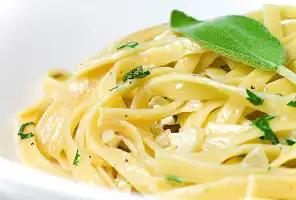




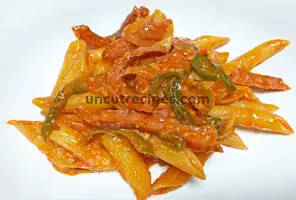






June 05, 2023
This recipe is absolutely fantastic! It's a real winner.